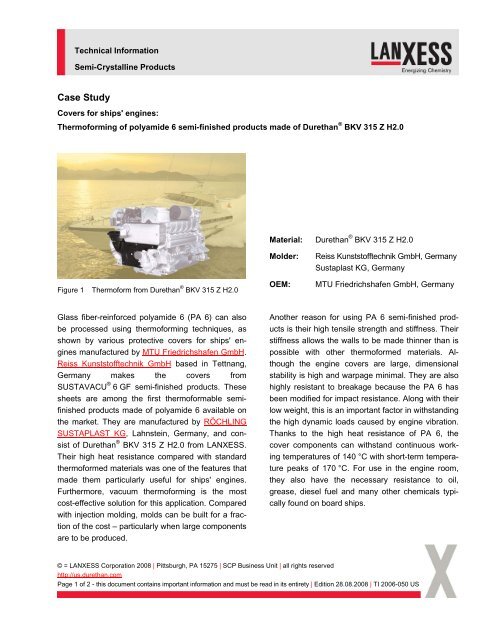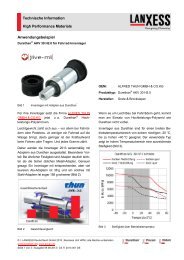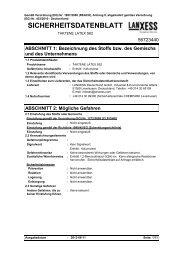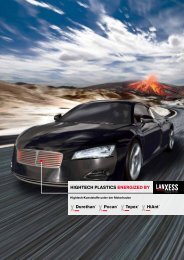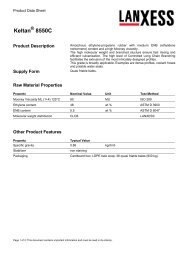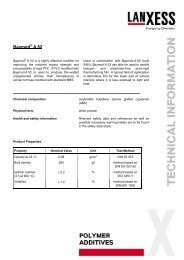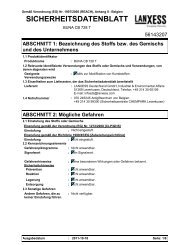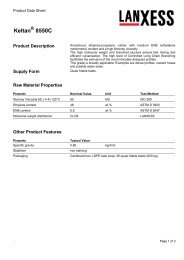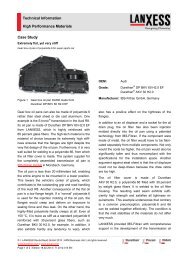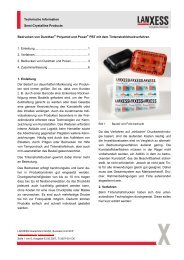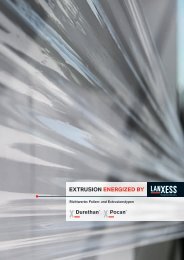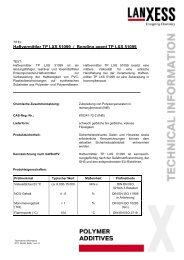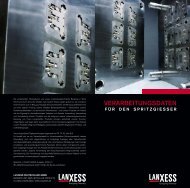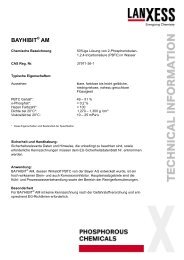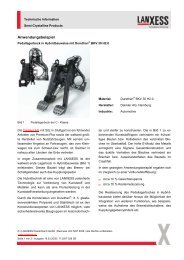Case Study - LANXESS
Case Study - LANXESS
Case Study - LANXESS
You also want an ePaper? Increase the reach of your titles
YUMPU automatically turns print PDFs into web optimized ePapers that Google loves.
Technical Information<br />
Semi-Crystalline Products<br />
<strong>Case</strong> <strong>Study</strong><br />
Covers for ships' engines:<br />
Thermoforming of polyamide 6 semi-finished products made of Durethan ® BKV 315 Z H2.0<br />
Figure 1 Thermoform from Durethan ® BKV 315 Z H2.0<br />
Glass fiber-reinforced polyamide 6 (PA 6) can also<br />
be processed using thermoforming techniques, as<br />
shown by various protective covers for ships' engines<br />
manufactured by MTU Friedrichshafen GmbH.<br />
Reiss Kunststofftechnik GmbH based in Tettnang,<br />
Germany makes the covers from<br />
SUSTAVACU ® 6 GF semi-finished products. These<br />
sheets are among the first thermoformable semifinished<br />
products made of polyamide 6 available on<br />
the market. They are manufactured by RÖCHLING<br />
SUSTAPLAST KG, Lahnstein, Germany, and consist<br />
of Durethan ® BKV 315 Z H2.0 from <strong>LANXESS</strong>.<br />
Their high heat resistance compared with standard<br />
thermoformed materials was one of the features that<br />
made them particularly useful for ships' engines.<br />
Furthermore, vacuum thermoforming is the most<br />
cost-effective solution for this application. Compared<br />
with injection molding, molds can be built for a fraction<br />
of the cost – particularly when large components<br />
are to be produced.<br />
Material: Durethan ® BKV 315 Z H2.0<br />
Molder: Reiss Kunststofftechnik GmbH, Germany<br />
Sustaplast KG, Germany<br />
OEM: MTU Friedrichshafen GmbH, Germany<br />
Another reason for using PA 6 semi-finished products<br />
is their high tensile strength and stiffness. Their<br />
stiffness allows the walls to be made thinner than is<br />
possible with other thermoformed materials. Although<br />
the engine covers are large, dimensional<br />
stability is high and warpage minimal. They are also<br />
highly resistant to breakage because the PA 6 has<br />
been modified for impact resistance. Along with their<br />
low weight, this is an important factor in withstanding<br />
the high dynamic loads caused by engine vibration.<br />
Thanks to the high heat resistance of PA 6, the<br />
cover components can withstand continuous working<br />
temperatures of 140 °C with short-term temperature<br />
peaks of 170 °C. For use in the engine room,<br />
they also have the necessary resistance to oil,<br />
grease, diesel fuel and many other chemicals typically<br />
found on board ships.<br />
© = <strong>LANXESS</strong> Corporation 2008 | Pittsburgh, PA 15275 | SCP Business Unit | all rights reserved<br />
http://us.durethan.com<br />
Page 1 of 2 - this document contains important information and must be read in its entirety | Edition 28.08.2008 | TI 2006-050 US
The engine covers partially replace earlier sheet<br />
metal structures. The largest cover component is<br />
920 mm long, 400 mm wide and weighs 1.25 kg.<br />
Like the other parts, it is manufactured from fivemillimeter-thick<br />
sheets in a thermoforming ratio of<br />
1 : 2.5.<br />
Durethan ® is a registered trademark of <strong>LANXESS</strong> Deutschland GmbH<br />
SUSTAVACU ® is a registered trademark of RÖCHLING SUSTAPLAST KG<br />
The Durethan ® BKV 315 Z H2.0 used to manufacture<br />
the semi-finished products is a branched PA 6<br />
with high pseudoplasticity, reinforced with 15 percent<br />
by weight glass fibers. This ensures a high melt<br />
stiffness which allows the sheets to be thermoformed.<br />
The manner in which you use and the purpose to which you put and utilize our products, technical assistance and information (whether verbal, written or by way<br />
of production evaluations), including any suggested formulations and recommendations, are beyond our control. Therefore, it is imperative that you test our<br />
products, technical assistance and information to determine to your own satisfaction whether they are suitable for your intended uses and applications. This<br />
application-specific analysis must at least include testing to determine suitability from a technical as well as health, safety and environmental standpoint. Such<br />
testing has not necessarily been done by us. Unless we otherwise agree in writing, all products are sold strictly pursuant to the terms of our standard conditions<br />
of sale. All information and technical assistance is given without warranty or guarantee, and is subject to change without notice. It is expressly understood and<br />
agreed that you assume and hereby expressly release us from all liability, in tort, contract or otherwise, incurred in connection with the use of our products,<br />
technical assistance and information. Any statement or recommendation not contained herein is unauthorized and shall not bind us. Nothing herein shall be<br />
construed as a recommendation to use any product in conflict with patents covering any material or its use. No license is implied or in fact granted under the<br />
claims of any patent.<br />
Typical Properties<br />
Property data is provided as general information only. Property values are approximate and are not part of the product specifications.<br />
Health and Safety<br />
Appropriate literature has been assembled which provides information concerning the health and safety precautions that must be observed when handling<br />
<strong>LANXESS</strong> products mentioned in this publication. Before working with these products, you must read and become familiar with the available information on their<br />
hazards, proper use, and handling. This cannot be overemphasized. Information is available in several forms, e.g., material safety data sheets (MSDS) and<br />
product labels. Consult your <strong>LANXESS</strong> Corporation representative or contact the Product Safety and Regulatory Affairs Department at <strong>LANXESS</strong>. For materials<br />
that are not <strong>LANXESS</strong> products, appropriate industrial hygiene and other safety precautions recommended by their manufacturer(s) must be followed.<br />
Regulatory Compliance<br />
Some of the end uses of the products described in this brochure must comply with applicable regulations, such as the FDA, NSF, USDA and CPSC. If you have<br />
any questions on the regulatory status of any <strong>LANXESS</strong> engineering thermoplastic, consult your <strong>LANXESS</strong> Corporation representative or contact the <strong>LANXESS</strong><br />
Regulatory Affairs Manager.<br />
Regrind<br />
Where end-use requirements permit, regrind may be used with virgin material in quantities specified in individual product information bulletins, provided that the<br />
material is kept free of contamination and is properly dried (see maximum permissible quantities and drying conditions in product information bulletins). Any<br />
regrind used must be generated from properly molded/extruded parts, sprues, runners, trimmings and/or film. All regrind used must be clean, uncontaminated,<br />
and thoroughly blended with virgin resin prior to drying and processing. Under no circumstances should degraded, discolored, or contaminated material be used<br />
for regrind. Materials of this type should be discarded. Improperly mixed and/or dried regrind may diminish the desired properties of a particular <strong>LANXESS</strong><br />
product. It is critical that you test finished parts produced with any amount of regrind to ensure that your end-use performance requirements are fully met. Regulatory<br />
or testing organizations (e.g., UL) may have specific requirements limiting the allowable amount of regrind. Because third party regrind generally does not<br />
have a traceable heat history or offer any assurance that proper temperatures, conditions, and/or materials were used in processing, extreme caution must be<br />
exercised in buying and using regrind from third parties. The use of regrind material should be avoided entirely in those applications where resin properties<br />
equivalent to virgin material are required, including but not limited to color quality, impact strength, resin purity, and/or load-bearing performance.<br />
Note:<br />
The information contained in this publication is current as of August, 2008. Please contact <strong>LANXESS</strong> Corporation to determine if this publication<br />
has been revised.<br />
© = <strong>LANXESS</strong> Corporation 2008 | Pittsburgh, PA 15275 | SCP Business Unit | all rights reserved<br />
http://us.durethan.com<br />
Page 2 of 2 - this document contains important information and must be read in its entirety | Edition 28.08.2008 | TI 2006-050 US


